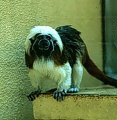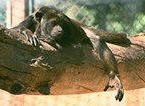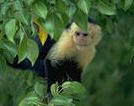 |
|
New World monkeys are limited to tropical
forest environments of southern Mexico, Central, and South America. All of
these monkeys are
predominantly arboreal and
mostly herbivorous.
They eat leaves, fruits, nuts, gums, and occasional small
prey such as insects. Today, there are at least 53 species
commonly divided into two families--Cebidae
![]() and
Callitricidae
and
Callitricidae
![]() .
.
 |
 |
||
| Cotton-top tamarin | Pygmy marmoset | ||
The Callitricidae
consist of marmosets
![]() and tamarins
and tamarins
![]() .
They range in weight from only 5 to 32 oz. (140-900 g.), but their thick fur and long
tails deceptively make them look larger and heavier.
The marmosets are the
smallest of all monkey species. Both
marmosets and tamarins are considered to be the most primitive monkeys
because of their anatomical and reproductive characteristics. Their thumbs are not
opposable. They have claws on all digits except for their big toes, which
have nails. They do not have prehensile tails.
They also lack the ability to change their facial expressions. Twin births are
common. All other primate species usually give birth
to only one child at a time. In addition,
marmoset and tamarin infants are usually carried on their father's back and
are generally only passed over to their mother for nursing.
Apparently, marmosets are unable to maintain a very stable
core body temperature.
It can vary as much as 8.5 F. (4 C.) over a day. Fortunately for
them, they live in warm forest environments that fluctuate little in
temperature.
.
They range in weight from only 5 to 32 oz. (140-900 g.), but their thick fur and long
tails deceptively make them look larger and heavier.
The marmosets are the
smallest of all monkey species. Both
marmosets and tamarins are considered to be the most primitive monkeys
because of their anatomical and reproductive characteristics. Their thumbs are not
opposable. They have claws on all digits except for their big toes, which
have nails. They do not have prehensile tails.
They also lack the ability to change their facial expressions. Twin births are
common. All other primate species usually give birth
to only one child at a time. In addition,
marmoset and tamarin infants are usually carried on their father's back and
are generally only passed over to their mother for nursing.
Apparently, marmosets are unable to maintain a very stable
core body temperature.
It can vary as much as 8.5 F. (4 C.) over a day. Fortunately for
them, they live in warm forest environments that fluctuate little in
temperature.
Baby pygmy marmosets--video clip from the Houston Zoo
(length = 1 mins, 35 secs)
The favorite food of tamarins and marmosets is carbohydrate rich tree sap which they tap by gnawing holes in trunks. Their territories are centered on the trees that they regularly exploit in this way. Some tamarin species eat flower nectar as well. The smaller marmosets venture into the very top of forest canopies to hunt insects that are abundant there.
Most of the New World monkeys are in the family Cebidae which is commonly subdivided into four subfamilies:
| 1. | Cebinae
|
| 2. | Aotinae
|
| 3. | Atelinae
|
| 4. | Pithecinae
|
 |
|
|
Howler monkey |
 |
|
|
Prehensile tails (spider monkeys) |
The Cebidae range in weight from 1.5 to 33 pounds (.7-14.5 kg.), which is significantly heavier than the marmosets and tamarins. The howler is the largest of the New World monkeys. Like the indris of Madagascar, they have developed the unusual habit of defending territory in the top branches of their forest canopies with vocalizations. The howlers do this with a specialized larynx and throat that expands like a balloon. Their deep, throaty sound is extraordinarily loud. In fact, a chorus of howler calls can carry for several miles if the winds are favorable.
Like the Old World monkeys, the Cebidae have nails on all of their fingers and toes. Social group size varies from that of the squirrel monkey, which lives in troops of up to 500 individuals, to that of the night (or owl) monkey, which lives in small nuclear family groups. The night monkey is also notable for being the only nocturnal monkey in the world. Unlike the prosimians, most monkeys and all apes are diurnal. Humans, of course, are by nature diurnal as well. Many of the larger Cebidae have strong prehensile tails that are largely hairless on the underside and have sensitive tactile pads. No other family of primates in either the New or the Old World has tails that are strong enough to function in this way as "third hands."
Spider monkeys--video clip from National Geographic Society
(length = 1 mins, 31 secs)
 |
|
| Capuchin monkey |
The Cebidae are generally very enterprising when it comes to obtaining food. For instance, capuchin monkeys venture out of the trees to hunt crabs, clams, and other small animals in mangrove swamps. They also hunt large insects and collect bird's eggs in the trees in addition to eating leaves and fruit. Some capuchin groups collect palm nuts, dry them out over several days, and crack them with rocks to get at the food inside. During the rainy season when mosquitoes bother them, capuchins rub their fur with crushed millipedes that produce a chemical insect repellent. During the early 20th century, trained capuchin monkeys were popular assistants for Italian organ grinders on the streets of North American cities. In recent years, some have been trained to be helpers for quadriplegics. Capuchins are able to do this not only because of their typical primate manual dexterity but also because of their relatively high level of intelligence for monkeys. They have the largest brain-to-body size ratio of any primate other than humans. It is not surprising that capuchins have been observed using simple tools in getting food. They use rocks for digging up plants as well as cracking open seeds and smashing pieces of cacti, tubers, and lizards into bite-size pieces. In addition, they use twigs to get insects out of small, constricted crevices and other places.
Helping hands with capuchin monkeys--video clip from Boston University
(length = 2 mins, 20 secs)
Note: Some primatologists consider the spider and howler monkeys to be in a separate family, the Atelidae, rather than the Cebidae.